Optimization of Pt-C Deposits by Cryo-FIBID: Substantial Growth Rate Increase and Quasi-Metallic Behaviour
Abstract
:1. Introduction
2. Materials and Methods
3. Results
3.1. Formation of a Homogeneous (CH3)Pt(CpCH3) Condensed Layer with Thickness of 20–40 nm
3.2. Electrical Characterization of Pt-C Cryo-FIBID Deposits
3.3. Compositional Analysis of Pt-C Cryo-FIBID Deposits by EDS
4. Discussion and Outlook
5. Conclusions
Supplementary Materials
Author Contributions
Funding
Acknowledgments
Conflicts of Interest
References
- Clark, R.; Tapily, K.; Yu, K.H.; Hakamata, T.; Consiglio, S.; O’Meara, D.; Wajda, C.; Smith, J.; Leusink, G. Perspective: New process technologies required for future devices and scaling. APL Mater. 2018, 6, 058203. [Google Scholar] [CrossRef]
- De Teresa, J.M.; Orús, P.; Córdoba, R.; Philipp, P. Comparison between Focused Electron/Ion Beam- Induced Deposition at Room Temperature and under Cryogenic Conditions. Micromachines 2019, 10, 799. [Google Scholar] [CrossRef] [PubMed] [Green Version]
- Gannon, T.J.; Gu, G.; Casey, J.D.; Huynh, C.; Bassom, N.; Antoniou, N. Focused ion beam induced deposition of low-resistivity copper material. J. Vac. Sci. Technol. B Microelectron. Nanom. Struct. 2004, 22, 3000. [Google Scholar] [CrossRef]
- Yasaka, A.; Aramaki, F.; Kozakai, T.; Matsuda, O. Nanoscale Imaging, Material Removal and Deposition for Fabrication of Cutting-edge Semiconductor Devices. Hitachi Rev. 2016, 65, 233–237. [Google Scholar]
- Hiley, C.I.; Scanlon, D.O.; Sokol, A.A.; Woodley, S.M.; Ganose, A.M.; Sangiao, S.; De Teresa, J.M.; Manuel, P.; Khalyavin, D.D.; Walker, M.; et al. Antiferromagnetism at T > 500 K in the layered hexagonal ruthenate SrRu2O6. Phys. Rev. B Condens. Matter Mater. Phys. 2015, 92, 104413. [Google Scholar] [CrossRef] [Green Version]
- Esposito, M.; Tasco, V.; Todisco, F.; Benedetti, A.; Tarantini, I.; Cuscunà, M.; Dominici, L.; De Giorgi, M.; Passaseo, A. Tailoring chiro-optical effects by helical nanowire arrangement. Nanoscale 2015, 7, 18081–18088. [Google Scholar] [CrossRef]
- Córdoba, R.; Orús, P.; Jelić, Ž.L.; Sesé, J.; Ibarra, M.R.; Guillamón, I.; Vieira, S.; Palacios, J.J.; Suderow, H.; Milosević, M.V.; et al. Long-range vortex transfer in superconducting nanowires. Sci. Rep. 2019, 9, 12386. [Google Scholar] [CrossRef] [Green Version]
- Sanz-Martín, C.; Magén, C.; De Teresa, J.M. High volume-per-dose and low resistivity of cobalt nanowires grown by Ga+ focused ion beam induced deposition. Nanomaterials 2019, 9, 1715. [Google Scholar] [CrossRef] [Green Version]
- Córdoba, R.; Orús, P.; Strohauer, S.; Torres, T.E.; De Teresa, J.M. Ultra-fast direct growth of metallic micro-and nano-structures by focused ion beam irradiation. Sci. Rep. 2019, 9, 14076. [Google Scholar] [CrossRef] [Green Version]
- Fernández-Pacheco, A.; De Teresa, J.M.; Córdoba, R.; Ibarra, M.R. Metal-insulator transition in Pt-C nanowires grown by focused-ion-beam- induced deposition. Phys. Rev. B Condens. Matter Mater. Phys. 2009, 79, 174204. [Google Scholar] [CrossRef]
- Burnett, T.L.; Kelley, R.; Winiarski, B.; Contreras, L.; Daly, M.; Gholinia, A.; Burke, M.G.; Withers, P.J. Large volume serial section tomography by Xe Plasma FIB dual beam microscopy. Ultramicroscopy 2016, 161, 119–129. [Google Scholar] [CrossRef] [PubMed]
- Hernandez-Ramirez, F.; Tarancon, A.; Casals, O.; Pellicer, E.; Rodriguez, J.; Romano-Rodriguez, A.; Morante, J.R.; Barth, S.; Mathur, S. Electrical properties of individual tin oxide nanowires contacted to platinum electrodes. Phys. Rev. B Condens. Matter Mater. Phys. 2007, 76, 085429. [Google Scholar] [CrossRef] [Green Version]
- Esposito, M.; Tasco, V.; Cuscunà, M.; Todisco, F.; Benedetti, A.; Tarantini, I.; De Giorgi, M.; Sanvitto, D.; Passaseo, A. Nanoscale 3D chiral plasmonic helices with circular dichroism at visible frequencies. ACS Photonics 2015, 2, 105–114. [Google Scholar] [CrossRef]
- Nanda, G.; van Veldhoven, E.; Maas, D.; Sadeghian, H.; Alkemade, P.F.A. Helium ion beam induced growth of hammerhead AFM probes. J. Vac. Sci. Technol. B Nanotechnol. Microelectron. Mater. Process. Meas. Phenom. 2015, 33, 06F503. [Google Scholar] [CrossRef] [Green Version]
- Wiedemair, J.; Moon, J.S.; Reinauer, F.; Mizaikoff, B.; Kranz, C. Ion beam induced deposition of platinum carbon composite electrodes for combined atomic force microscopy-scanning electrochemical microscopy. Electrochem. Commun. 2010, 12, 989–991. [Google Scholar] [CrossRef]
- Bresin, M.; Thiel, B.L.; Toth, M.; Dunn, K.A.; Toth, M. Focused electron beam-induced deposition at cryogenic temperatures. J. Mater. Res. 2011, 26, 357–364. [Google Scholar] [CrossRef]
- Thorman, R.M.; Matsuda, S.J.; McElwee-White, L.; Fairbrother, D.H. Identifying and Rationalizing the Differing Surface Reactions of Low-Energy Electrons and Ions with an Organometallic Precursor. J. Phys. Chem. Lett. 2020, 11, 2006–2013. [Google Scholar] [CrossRef]
- De Teresa, J.M.; Cárdoba, R.; Fernández-Pacheco, A.; Montero, O.; Strichovanec, P.; Ibarra, M.R. Origin of the difference in the resistivity of as-grown focused-ion- and focused-electron-beam-induced Pt nanodeposits. J. Nanomater. 2009, 2009, 936863. [Google Scholar] [CrossRef] [Green Version]
- Mutzke, A.; Schneider, R.; Eckstein, W.; Dohmen, R. SDTRIMSP Version 5.00; Max-Planck-Institut für Plasmaphysik: Greifswald, Germany, 2011; Volume IPP 12/8. [Google Scholar]
- Mutzke, A.; Eckstein, W. Ion fluence dependence of the Si sputtering yield by noble gas ion bombardment. Nucl. Instrum. Methods Phys. Res. Sect. B Beam Interact. Mater. Atoms 2008, 266, 872–876. [Google Scholar] [CrossRef] [Green Version]
- Rzeznik, L.; Fleming, Y.; Wirtz, T.; Philipp, P. Experimental and simulation-based investigation of He, Ne and Ar irradiation of polymers for ion microscopy. Beilstein J. Nanotechnol. 2016, 7, 1113–1128. [Google Scholar] [CrossRef] [Green Version]
- Bresin, M.; Toth, M.; Dunn, K.A. Direct-write 3D nanolithography at cryogenic temperatures. Nanotechnology 2013, 24, 035301. [Google Scholar] [CrossRef] [PubMed]
- Blagg, K.; Allen, P.; Lu, T.-M.; Lilly, M.P.; Singh, M. Focused ion beam deposited carbon-platinum nanowires for cryogenic resistive thermometry. Carbon 2020, 169, 482–487. [Google Scholar] [CrossRef]
- Moulick, R.G.; Panaitov, G.; Du, L.; Mayer, D.; Offenhäusser, A. Neuronal adhesion and growth on nanopatterned EA5-POPC synthetic membranes. Nanoscale 2018, 10, 5295–5301. [Google Scholar] [CrossRef]
- Grigorescu, A.E.; Hagen, C.W. Resists for sub-20-nm electron beam lithography with a focus on HSQ: State of the art. Nanotechnology 2009, 20, 292001. [Google Scholar] [CrossRef] [PubMed]
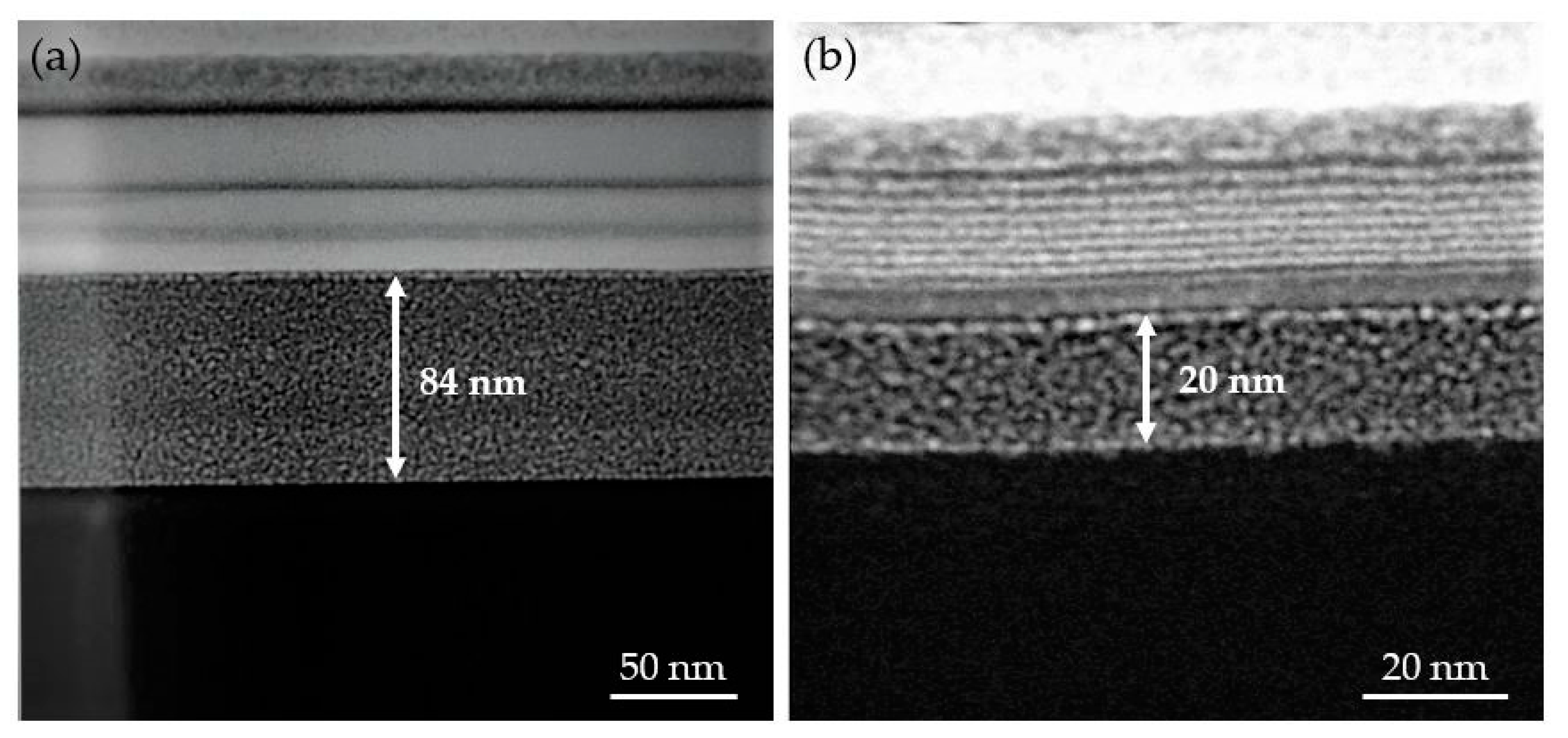

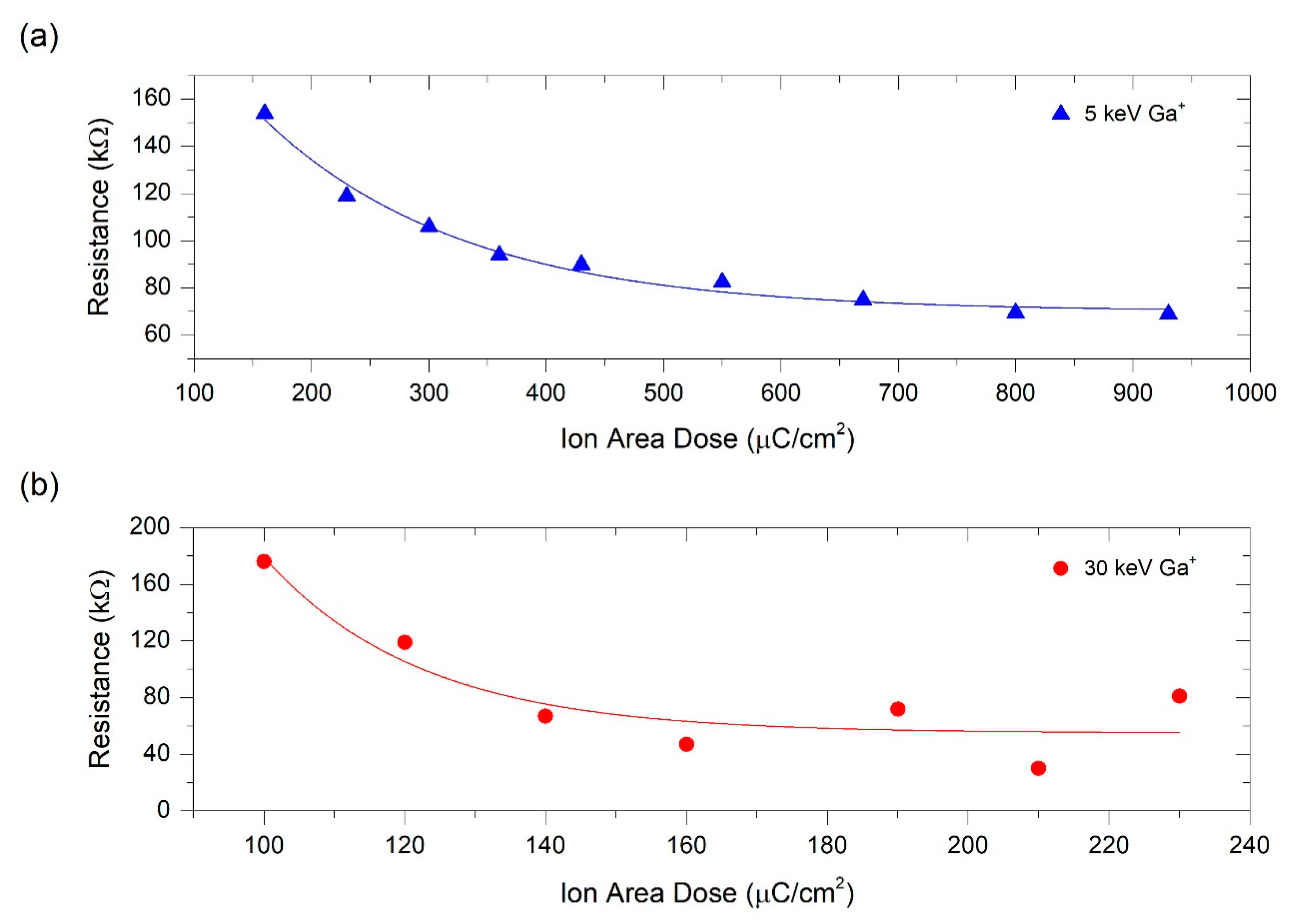
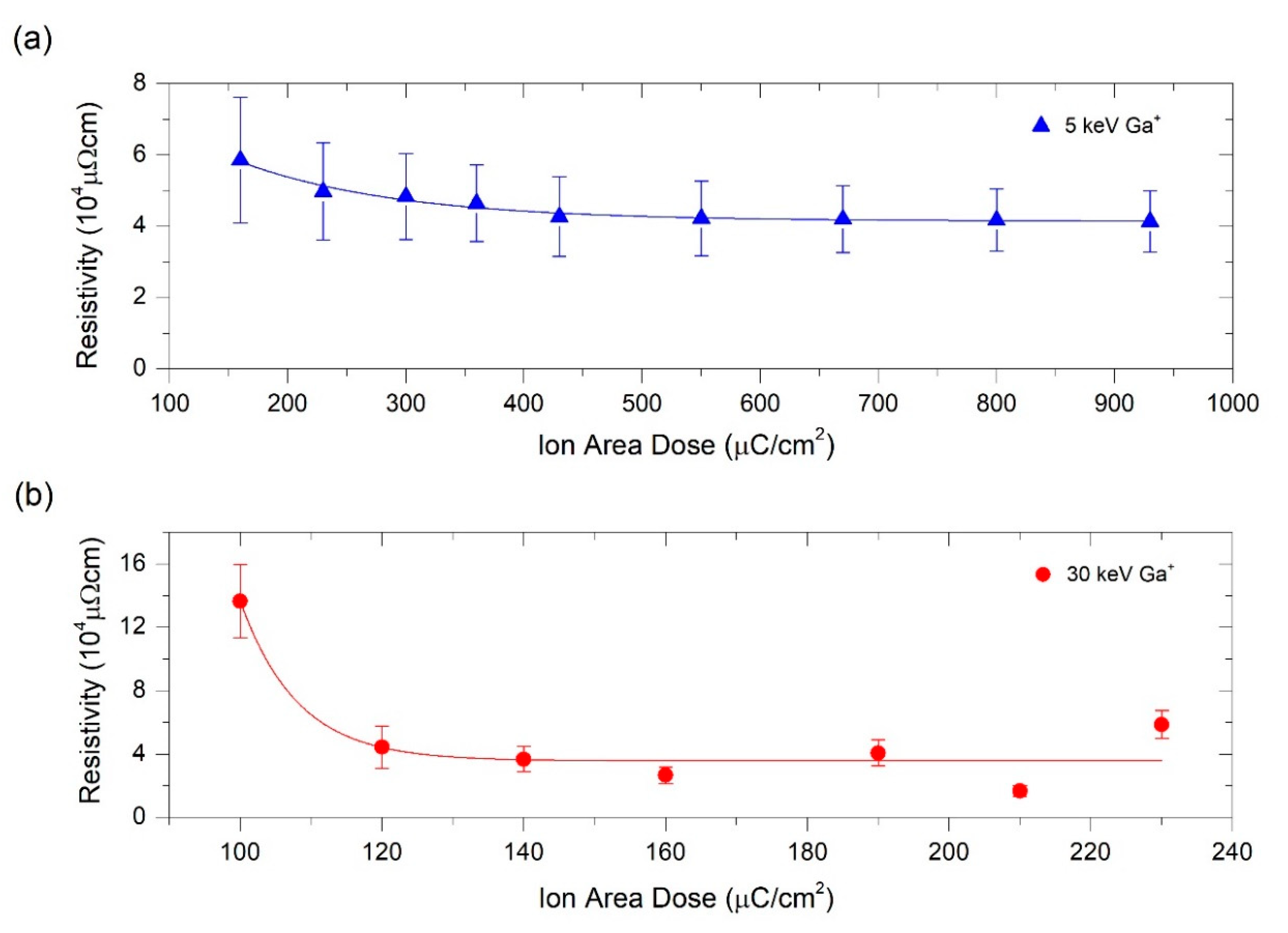
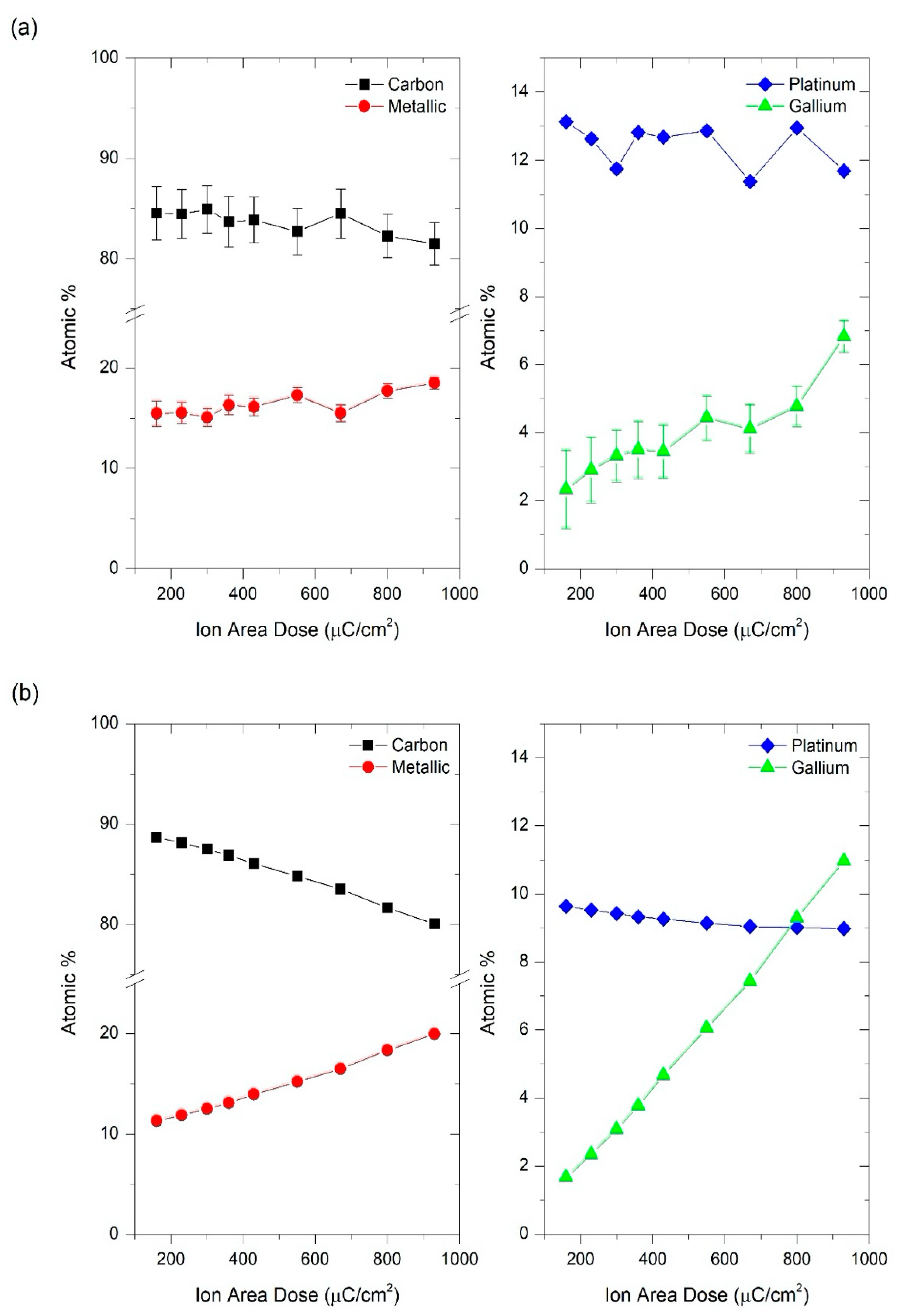

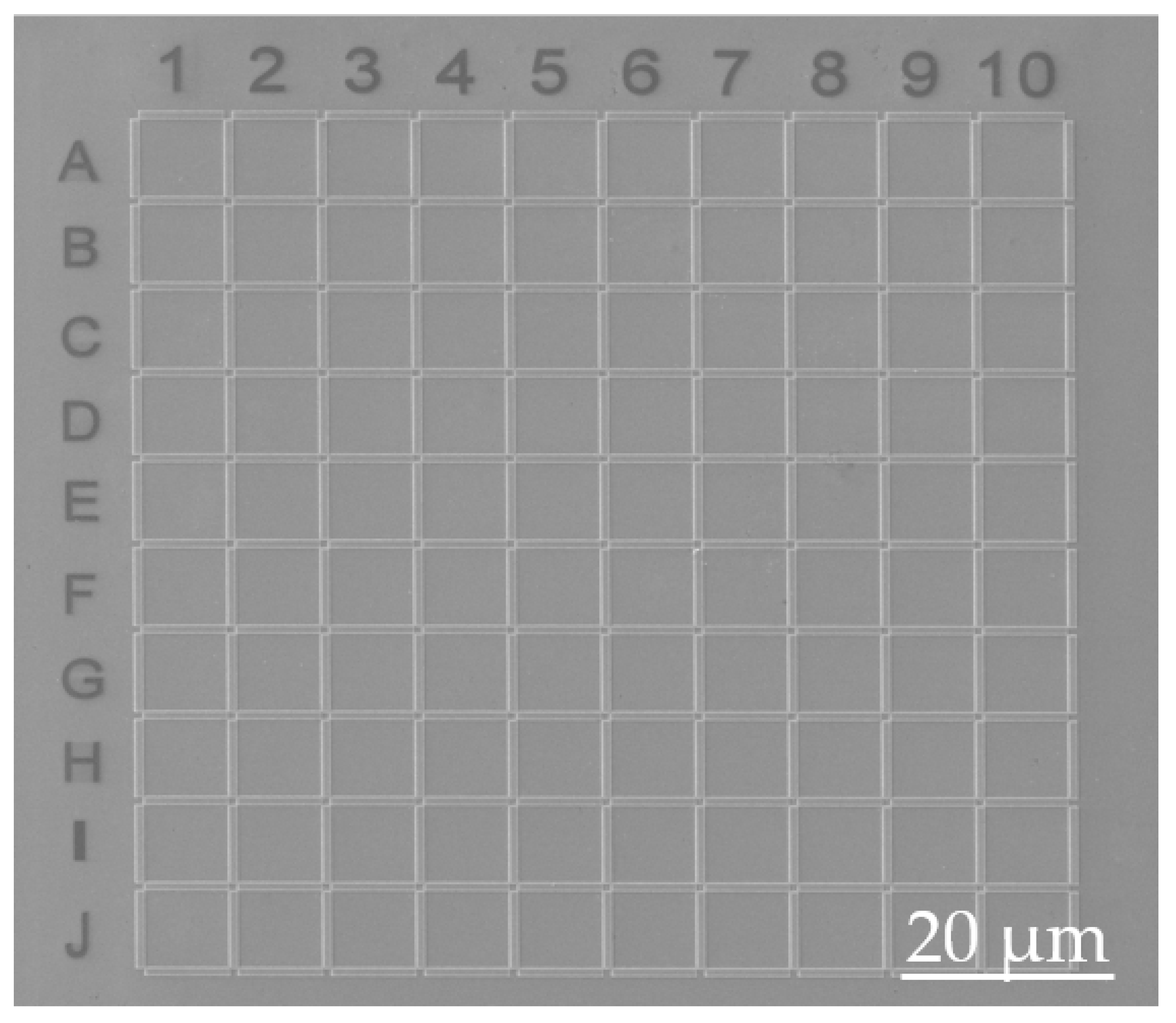
© 2020 by the authors. Licensee MDPI, Basel, Switzerland. This article is an open access article distributed under the terms and conditions of the Creative Commons Attribution (CC BY) license (http://creativecommons.org/licenses/by/4.0/).
Share and Cite
Salvador-Porroche, A.; Sangiao, S.; Philipp, P.; Cea, P.; Teresa, J.M.D. Optimization of Pt-C Deposits by Cryo-FIBID: Substantial Growth Rate Increase and Quasi-Metallic Behaviour. Nanomaterials 2020, 10, 1906. https://doi.org/10.3390/nano10101906
Salvador-Porroche A, Sangiao S, Philipp P, Cea P, Teresa JMD. Optimization of Pt-C Deposits by Cryo-FIBID: Substantial Growth Rate Increase and Quasi-Metallic Behaviour. Nanomaterials. 2020; 10(10):1906. https://doi.org/10.3390/nano10101906
Chicago/Turabian StyleSalvador-Porroche, Alba, Soraya Sangiao, Patrick Philipp, Pilar Cea, and José María De Teresa. 2020. "Optimization of Pt-C Deposits by Cryo-FIBID: Substantial Growth Rate Increase and Quasi-Metallic Behaviour" Nanomaterials 10, no. 10: 1906. https://doi.org/10.3390/nano10101906
APA StyleSalvador-Porroche, A., Sangiao, S., Philipp, P., Cea, P., & Teresa, J. M. D. (2020). Optimization of Pt-C Deposits by Cryo-FIBID: Substantial Growth Rate Increase and Quasi-Metallic Behaviour. Nanomaterials, 10(10), 1906. https://doi.org/10.3390/nano10101906








